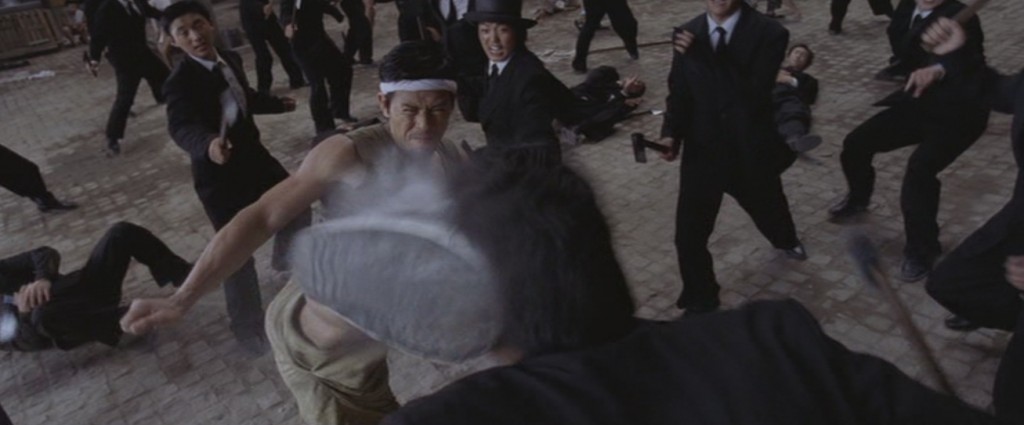Kung Fu Hustle (Stephen Chow, 2004)
It used to be possible to split martial arts films roughly into two broad categories: those that featured largely unassisted physical feats, such as the films of Jackie Chan; and those reliant on more over-the-top, heavily faked wire-work, such as Once Upon a Time in China or Crouching Tiger, Hidden Dragon. The last few years, however, have seen the emergence of a variant of the latter: computer assisted martial arts, as seen prominently in the fight with many Agent Smiths in The Matrix Reloaded. Here the computer fakery moves beyond just the digital removal of wires, and starts creating digital stunt men and props. Once a fight is at least partially animated inside a computer, anything is possible. In unassisted martial arts, a kick might knock someone over. With wire-work, it might send them flying across a room. With digital martial arts, however, it can send them over the horizon.
The more a filmmaker starts “faking” martial arts, the more extreme the action needs to get to remain impressive. And since computers give the freedom to do pretty much anything, they throw down a challenge to directors to come up with ever more over-the-top concepts. The logical outcome, then, is a film as delirious as Stephen Chow’s Kung Fu Hustle. The film features some brief but impressive displays of “genuine” kung fu, and a fair bit of Crouching Tiger style wire-work, but uses these as lead-ins to outlandish computer-enhanced fight scenes. Instead of justifying the over-the-top nature of these sequences with an elaborate explanatory set-up (as in Matrix films), Kung Fu Hustle unfolds in a cartoon universe. Western reviewers who have in the past looked for a western influence on martial arts films have tended to point to musicals or the physical comedy of Buster Keaton, but this time the obvious Hollywood predecessors are the Warner and MGM cartoons of the forties and fifties.
The film is co-produced, co-written, co-scored and directed by its star Stephen Chow, yet it isn’t structured like a vanity piece. While Chow might ultimately triumph, his character loiters on the fringes of the narrative for most of its length, with his moment in the sun held until very late in the film. In the meantime, the shambolic but functional plot contrives to bring various prospective martial arts heroes into conflict. The story is constructed as a series of escalations, with both heroes and villains progressively falling by the wayside as they are supplanted by someone tougher. So in the opening scene we establish the Axe Gang as the meanest, toughest, nastiest gang of villains you’ll ever see: by the thirty-minute mark, they have been well and truly bested by a bunch of tough, heroic slum dwellers… who in turn will face stronger challengers still.
Such an episodic structure allows a lot of room to consider the merits of the different sequences separately, and I loved parts of the movie and found others pedestrian. Fortunately, however, the good parts far outweigh the weaker sections. The film’s opening sequence, introducing the Axe Gang, is its best, with the gang dancing in formation to a jazzy Mancini-esque tune. It’s the most purely musical sequence, as well as the least “enhanced,” and it’s therefore the part closest to my own tastes: I’m a purist (or perhaps a luddite) when it comes to this kind of film. A few minutes later, my heart sank at an uninspired gag involving an obviously computer generated soccer ball: I feared the fakery would take over… as indeed it does. There’s a slightly awkward quality to cartoon gags done with live actors that I find off-putting, and some moments in this film have that not-quite-right feel that characterised The Mask. Fortunately, however, Chow is sufficiently imaginative that the jokes are often very clever, and the best moments had me reassessing my prejudices against these kinds of techniques. (I particularly liked an early sequence where Chow picks out a series of opponents from a crowd, which has a couple of laugh-out-loud moments).
The martial arts choreography is by Yuen Wo Ping, who has basically sewn up the big-budget martial arts market: he was action choreographer on Crouching Tiger, Hidden Dragon, the Kill Bill films, the Matrix series, and – long ago – the director of two of Jackie Chan’s breakthrough films, Drunken Master and Snake in Eagle’s Shadow. It’s impressively done, although as I said back in my review of the first Kill Bill, it is becoming hard for him to top himself. (Interestingly, former Chan collaborator and action star Sammo Hung is also credited as a contributor to the action sequences). Chow’s direction is gimmicky, but confident and fluid, with breathtaking moments. The resulting film is very much a mixed bag, but it’s a bag full of interesting things, and you come out with the feeling that you’ve seen the medium stretched to its limits.
